This post will walk you through the steps to creating a whole wheat sourdough starter from scratch. A simple combination of flour, water, and time will set you up to begin baking all kinds of delicious, nutritious loaves, bagels, muffins, and more – all from your very own sourdough starter.
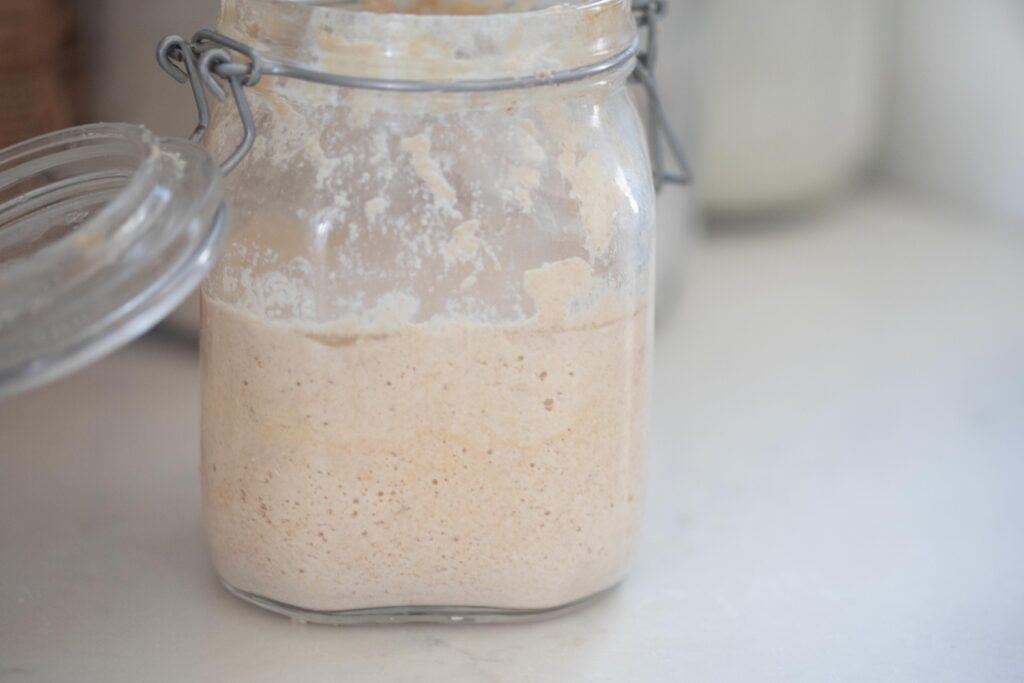
Sourdough Starter Recap
The art of sourdough baking is nothing new. A long time before commercial yeast, bread found its rise with the help of a living culture of natural yeasts and good bacteria – sourdough starter. These living organisms are found everywhere in our environment.
When we leave a little bit of flour and water in a warm spot for a length of time, wild yeast and good bacteria get to work consuming the sugars in the flour and water mixture, giving off small bubbles of carbon dioxide. These bubbles give rise to our recipes when we let the dough rest.
This process of fermentation makes the grains more digestible, and the nutrients become more bioavailable.
These natural benefits have been largely replaced by the convenience of instant yeast and quicker rise times.
While we save time, we have also been losing the nutritional benefits and delicious flavors.
But sourdough starter has been making a comeback. It is finding its way back into the kitchens of average folks, its popularity rising because of the many benefits, and maybe also because of the extreme satisfaction that comes with learning to master this lost art.
I use my starter constantly, and I’ve been caring for it for years now. It’s practically a member of our family.
Sourdough starter is a living thing, incredibly resilient, and much simpler than most think.
So where do you begin?
Sure, you can buy a starter and get going from there.
Or you can ask a sourdough friend for some of theirs, and I’ve found they’re always excited to share.
But I think the easiest way starts in your very own kitchen. Did you know you can grow your own starter from scratch with a little whole grain flour and some water?
I have a post for How to Make a Sourdough Starter already, and while the process is pretty much the same, that post is aimed at using all-purpose flour, and whole wheat is different.
For those wanting to use whole wheat flour in a starter, keep on reading!
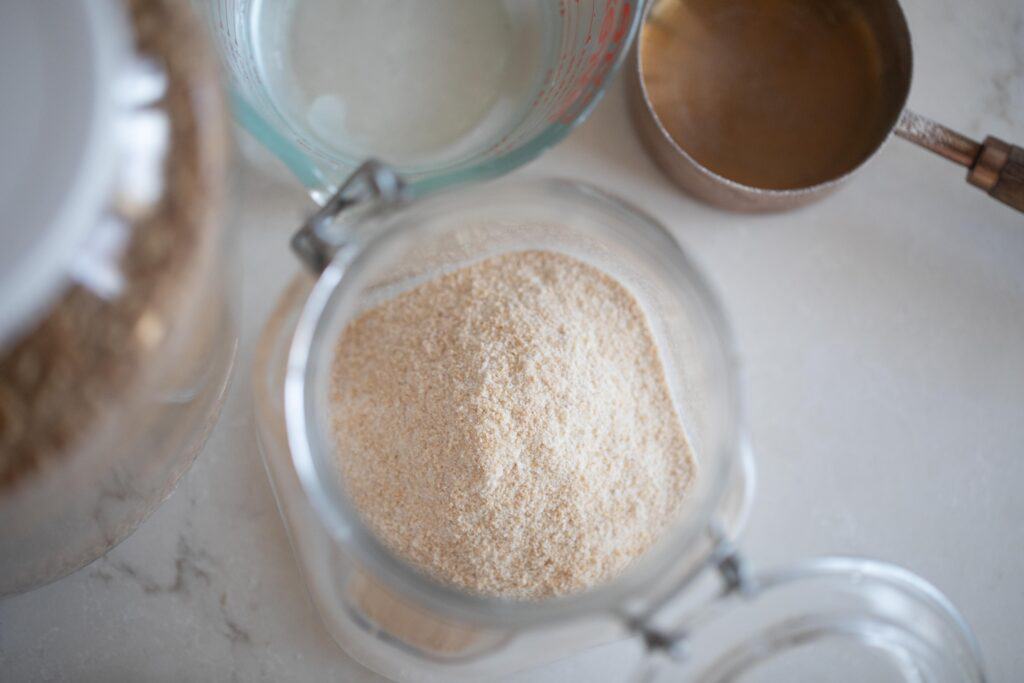
Some Differences of Whole Wheat Flour
The choice of flour in a sourdough starter is completely up to you. Whole wheat is one of many great options, so let’s discuss why we might choose whole wheat.
Whole grains are made up of three main components: the bran, the endosperm, and the germ.
Each component offers some nutrition, though some more than others.
Bran is an excellent source of fiber, while the germ contains healthy fats and vitamins like B and E, and the endosperm contributes primarily starch.
Wheat flour is a whole grain – bran, endosperm, and germ – processed using commercial equipment or your own little grain mill at home. Each component is present, contributing to the darker color of the flour.
White flour is the result of separating the endosperm, the starchiest component, from the bran and germ. Flour composed of just the endosperm of the wheat berry results in white flour being white, as the brown outer layer of bran has been removed.
Wheat flour, therefore, boasts a much higher level of nutrition.
Also, because all parts of the wheat berry are present in unprocessed whole wheat, this type of flour uses more liquid. As such, a whole wheat sourdough recipe will typically require more hydration than others.
Self-Paced Online Course
Simple Sourdough
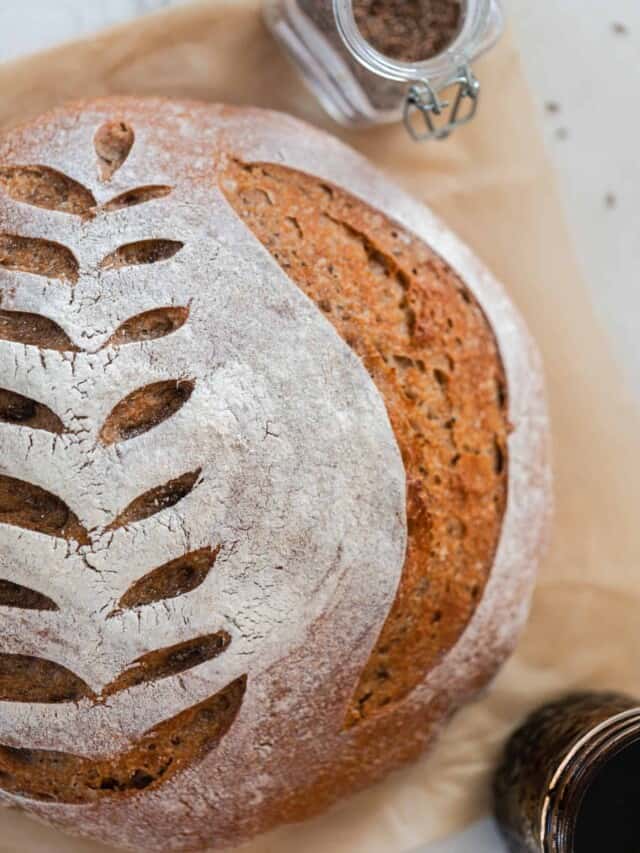
What’s in this course?
- Make your own robust starter
- Bake your first loaves of sourdough bread
- Understand sourdough better
- Expand your sourdough bread repertoire
- Download my Complete Recipe Book
What’s To Love About Whole Wheat
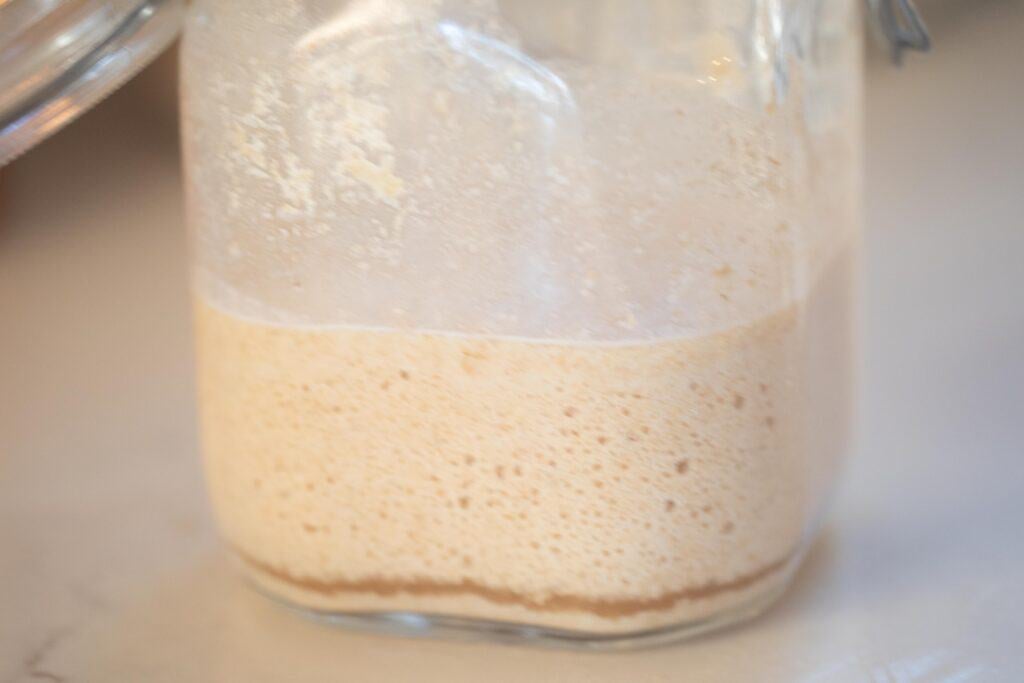
Quicker rise
Sourdough starter made with whole wheat flour ferments much more rapidly than white flour. This is because the wild yeasts respond more vigorously to having all the parts of the wheat berry present, happily consuming the flour and water much more quickly.
Wheat flour is great for jumpstarting your sourdough starter or for using it all the time as your primary flour.
Deeper flavor
Whole wheat flour has a very deep, complex taste, with slight but noticeably sweeter notes than all-purpose or white. Many people prefer whole wheat flour for its heartiness.
This flavor boost comes from maintaining the bran and germ and often influences the tanginess from the fermentation. This results in a more sour flavor.
A sourdough starter made with whole wheat flour will contribute to a more richly flavored bread, especially when used in combination with whole wheat flour in a recipe.
Hearty Texture
Whole wheat flour recipes produce a denser loaf of bread than more processed flour. This is due to a lower gluten content in whole wheat. This should be expected and isn’t really a downside.
This density works wonderfully for a sturdy crust, chewy texture, and a well-structured loaf that accompanies any meal very well.
Used in a sourdough starter, whole wheat flour will hold fewer bubbles and tends to not rise a bread as dramatically during the bulk fermentation, unless used with a more glutenous flour like bread flour or all-purpose.
Whole Wheat Sourdough Starter Maintenance
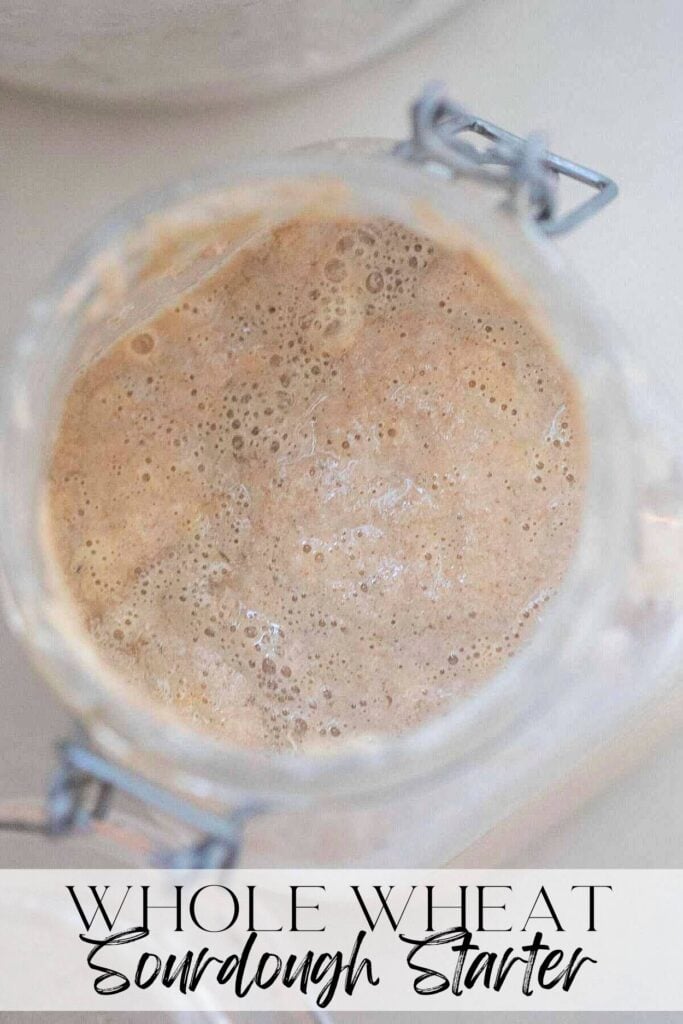
Daily Use on the Counter
A starter kept at room temperature requires a consistent feeding of flour and water every day.
Even though whole wheat is a higher hydration flour in recipes, you’ll still stick with equal parts flour and water for the starter.
Keep in mind that the warmer the conditions, the quicker the wild yeast and bacteria will use up the sugars and reach their peak.
You should plan on using your starter every day on this schedule, or at least several times a week while discarding on the off days.
I like to keep a jar of discard in the refrigerator to use specifically in discard recipes.
I don’t actually discard my discard, but use it up in recipes made specifically for this purpose. For ideas on how to do the same, check out my post 35+ Sourdough Discard Recipes!
Refrigerated Starter
For the average person, storing your starter in the refrigerator makes a lot of sense.
The cold slows down the fermentation process significantly, which is more accommodating for those baking weekly or every other week.
A refrigerated starter should be fed about every 7 days to keep it healthy. Depending on your starter and flour/water ratios, you may get by with feeding every other week.
Keep the container covered tightly when refrigerated.
This method requires a bit of planning when used as an active starter, as the starter won’t be ready to go right out of the fridge.
For best results, it will need to be placed on the counter and fed on the day before you plan to use it to rise a recipe.
For recipes that don’t require rise or use added leavening agents, such as sourdough chocolate chip cookies, Dutch baby pancakes, or discard crackers, simply bring your discard to room temperature before adding to a recipe.
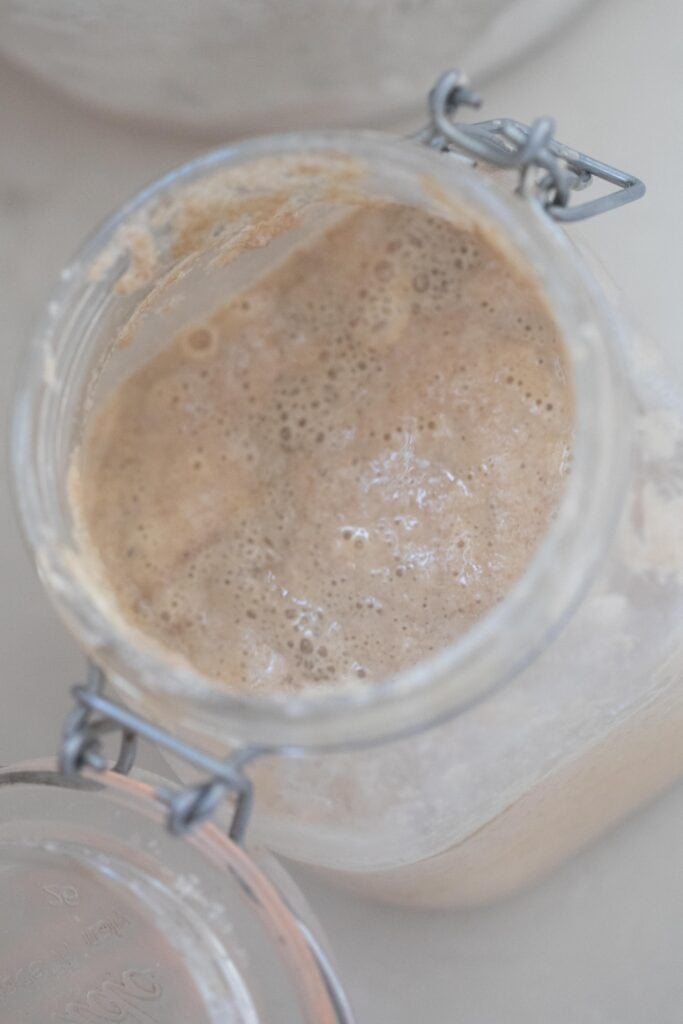
When Is My Starter Ready?
The most accurate way to know if your starter is ready is by identifying visible signs of activity, such as bubbles or doubling in size.
The age of your starter matters as well, since a very young starter may perform much more weakly than an older one.
One method I would not recommend is called the float test, and it is already a somewhat inconsistent indicator of a sourdough starter’s readiness.
It works in this way: The activity of a starter will generate carbon dioxide bubbles within, causing a sample of the starter that is placed in a glass of water to float. This would indicate an active starter.
However, whole wheat flour has a lower gluten content than bread flour or all-purpose flour, which results in less elasticity and a weaker gluten network.
As such, this type of starter won’t hold lots of bubbles, which will cause the starter to sink. It will likely fail this specific test, though it very well could still be active and ready to bake.
Tips
- The temperature of your home plays a big role in the fermentation process. A warmer home will lead to a far quicker rise, whereas a cooler home slows the rise significantly.
- If you need a warm place to keep your starter, some common solutions are near a heat source like a hearth, near an operating oven or stove, on top of the refrigerator, or in a sunny window.
- Recipes made with whole wheat starter and flour work well with longer autolyse and rest periods, allowing this very thirsty whole grain flour to absorb the liquids more completely.
- A common method of measuring the growth of your starter is placing a rubber band around the jar level with your starter upon feeding. You can later check if the starter has risen past the marker, measuring the growth and timing of your starter’s peak activity. This typically happens anywhere between 4 and 12 hours after feeding.
- Starter consistency should be similar to that of pancake batter.
Tools You Will Need
Glass bowl – You will be keeping the starter in this bowl for several days, so a non-porous material like glass is best.
Wooden spoon – Metal can react with the acid in sourdough fermentations, so I generally use wooden utensils.
Measuring cups – You can use a food scale if you want to be very accurate, but I find measuring cups to be sufficient.
Tea towel – To keep foreign particles out of the bowl.
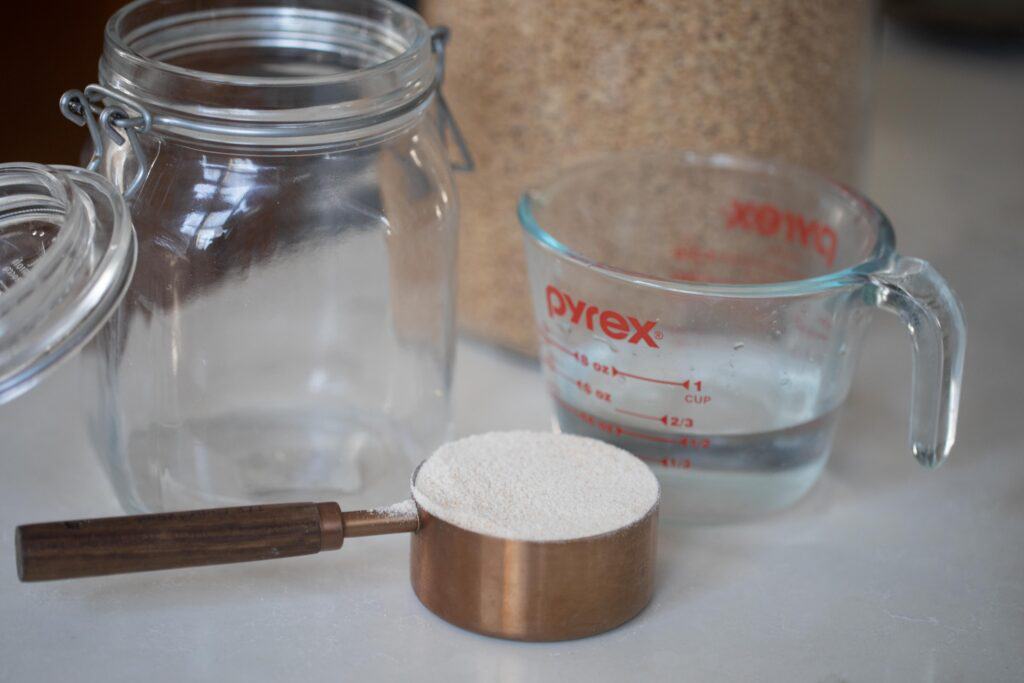
Ingredients
Whole wheat flour – I use fresh milled flour.
Water – Filtered water is helpful to avoid chlorine and other chemicals often found in tap water.
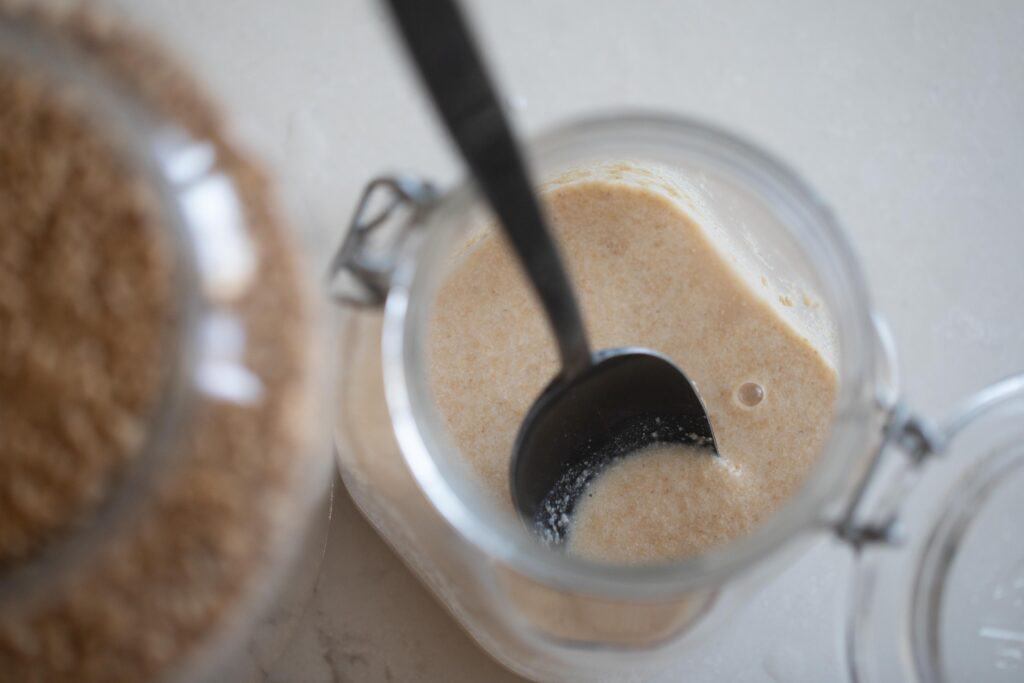
How to Make Whole Wheat Sourdough Starter
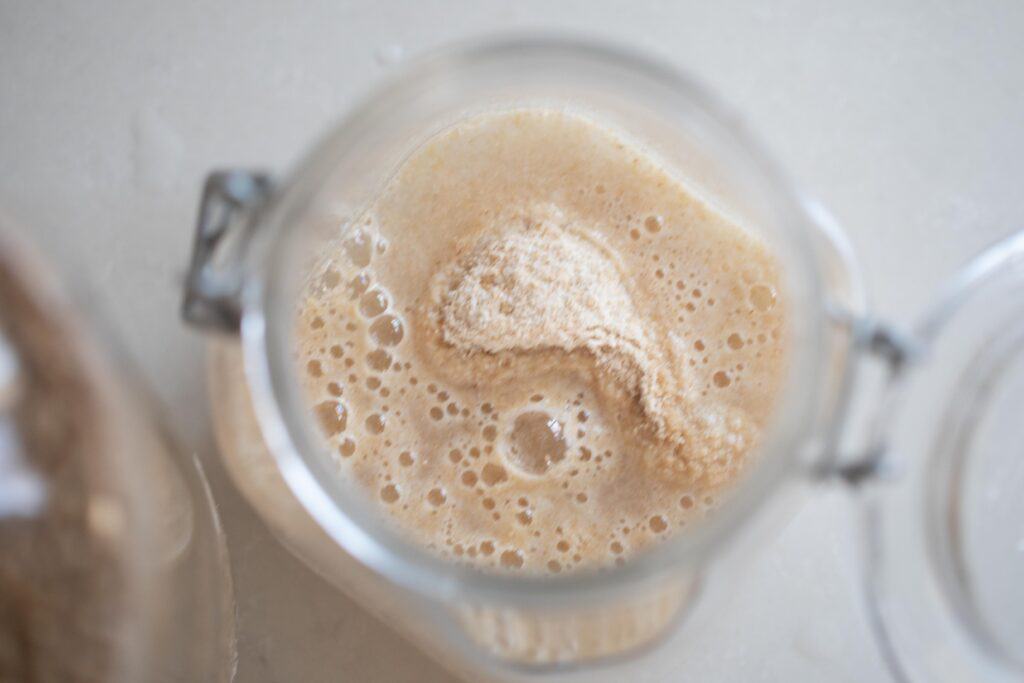
Day 1:
Combine one cup of whole wheat flour with one cup of filtered water in your glass bowl. Stir well, scraping down the sides of the bowl. Cover your bowl with a clean tea towel and let it sit at room temperature for 24 hours.
Day 2:
Pour out and discard half of the flour and water mixture, then repeat the steps of day one. One cup of flour, one cup of water, stir thoroughly, cover, and set aside.
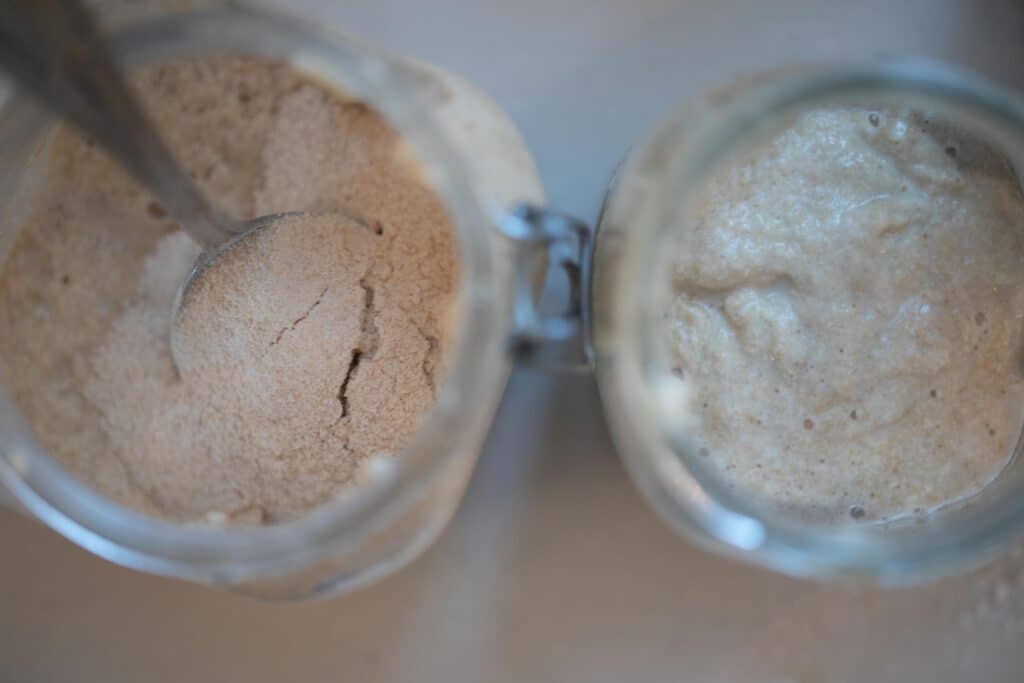
Day 3-5:
For days 3, 4, and 5, repeat the instructions from day 2. Discard, feed, stir, cover, and wait 24 hours.
Day 6-7:
Continue the steps from days 2-5, but begin feeding every 12 hours now, rather than every 24 hours.
Day 7:
After one week, your new starter should be showing signs of activity. With the feeding schedule and elapsed time, enough wild yeast and good bacteria should be present to attempt your first rise. Look for bubble foam on top, bubbles throughout the starter, or doubling in size.
After day 7:
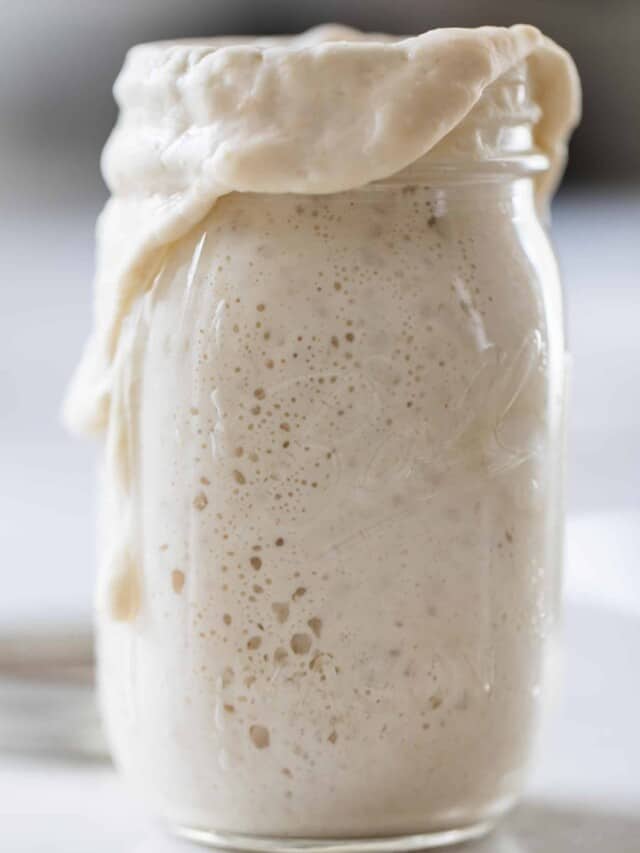
Start baking with your sourdough starter. Store in the fridge if not using daily. Feed once a week in the fridge or at least every 12-24 hours at room temperature equal portions starter, water, and whole wheat flour.
FAQ
A mature starter is difficult to ruin unless it is being severely neglected. Missing a feeding won’t kill your starter, and some smells may seem suspicious while being completely normal. The biggest warning would be signs of mold growth. If this happens, toss the starter. This is not a common issue, though, as mold spores don’t thrive in the acidity of a mature, fermenting culture of wild yeast. Pink tinges or dark liquid are all easily remedied, though.
Whole wheat bread, as a general rule, comes out dense. This is because the bran breaks up the gluten network in a way that weakens the elasticity and significantly reduces the capture of carbon dioxide bubbles. These bubbles are what give your bread rise, determining the fluffy, light, airy textures. Without the elasticity of the gluten, a whole wheat loaf is more closely knit and, therefore, dense.
If your loaf seems to be unbearably dense, try extending rise times and/or working the dough more whether by kneading or stretching and folding.
You certainly can. It’s as simple as feeding your starter whole wheat flour and water at room temperature every 12 hours, which is the basic schedule for countertop, frequently used sourdough starter. Discard and feed each day with the new flour, and after a few days, your starter will be successfully converted.
The main reason for a crumbly loaf is having too much flour. Whole wheat recipes can be tricky, trying to determine the correct hydration level for this flour that just generally needs more water than others. Adding more flour seems like the right solution to a sticky dough, while better results might actually be found by increasing fermentation time and handling (kneading, stretch and folds, etc) to increase the gluten structure.
Whole wheat sourdough starter can be used in any recipe calling for starter or discard, unless of course the recipe is aiming to be gluten-free.
Your container will build up sourdough residue pretty quickly, so I just scrape the sides down to keep the container as clean as possible. Extra starter on the top and rim are messy and potentially susceptible to mold, which is always problematic. Cleaning your jar thoroughly is a good idea to do now and then, just to keep surfaces tidy.
Check out some of my favorite sourdough recipes here:
- Seeded Sourdough
- 100% Whole Wheat Sourdough Bread
- The Best Sourdough Pancakes
- Sourdough Banana Bread
- Homemade Sourdough Bagels
If you try this recipe and love it, I would love if you could come back and give it 5 stars! Tag me on Instagram @farmhouseonboone
Whole Wheat Sourdough Starter
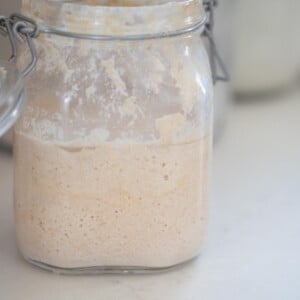
Equipment
- Jar or bowl
Ingredients
- Whole wheat flour
- Water
Instructions
- Day 1: Combine one cup of whole wheat flour with one cup of filtered water in your glass bowl. Stir well, scraping down the sides of the bowl. Cover your bowl with a clean tea towel and let it sit at room temperature for 24 hours.
- Day 2: Pour out and discard half of the flour and water mixture, then repeat the steps of day one. One cup of flour, one cup of water, stir thoroughly, cover, and set aside.
- Day 3-5: For days 3, 4, and 5, repeat the instructions from day 2. Discard, feed, stir, cover, and wait 24 hours.
- Day 6-7: Continue the steps from days 2-5, but begin feeding every 12 hours now, rather than every 24 hours.
- Day 7: After one week, your new starter should be showing signs of activity. With the feeding schedule and elapsed time, enough wild yeast and good bacteria should be present to attempt your first rise. Look for bubble foam on top, bubbles throughout the starter, or doubling in size.
- After day 7: Start baking with your sourdough starter. Store in the fridge if not using daily. Feed once a week in the fridge or at least every 12-24 hours at room temperature equal portions starter, water, and whole wheat flour.
Notes
- The temperature of your home plays a big role in the fermentation process. A warmer home will lead to a far quicker rise, whereas a cooler home slows the rise significantly.
- If you need a warm place to keep your starter, some common solutions are near a heat source like a hearth, near an operating oven or stove, on top of the refrigerator, or in a sunny window.
- Recipes made with whole wheat starter and flour work well with longer autolyse and rest periods, allowing this very thirsty whole grain flour to absorb the liquids more completely.
- A common method of measuring the growth of your starter is placing a rubber band around the jar level with your starter upon feeding. You can later check if the starter has risen past the marker, measuring the growth and timing of your starter’s peak activity. This typically happens anywhere between 4 and 12 hours after feeding.
Nutrition information is automatically calculated, so should only be used as an approximation.

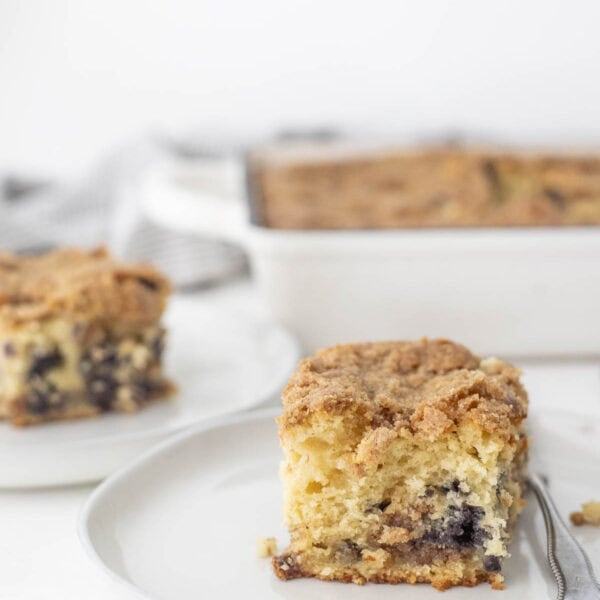
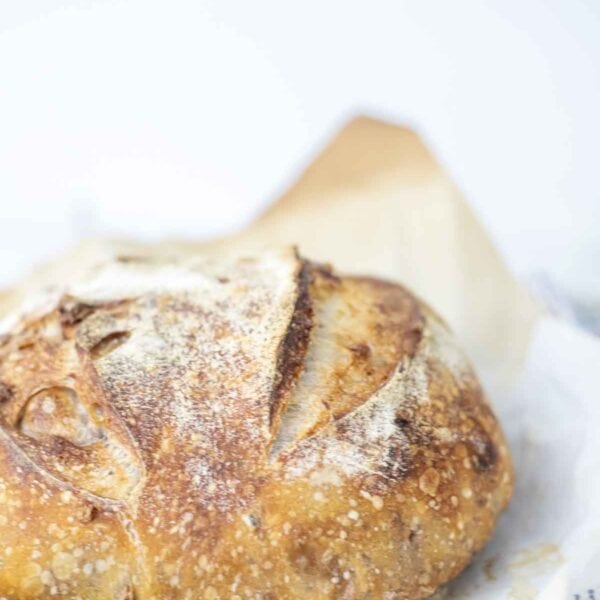
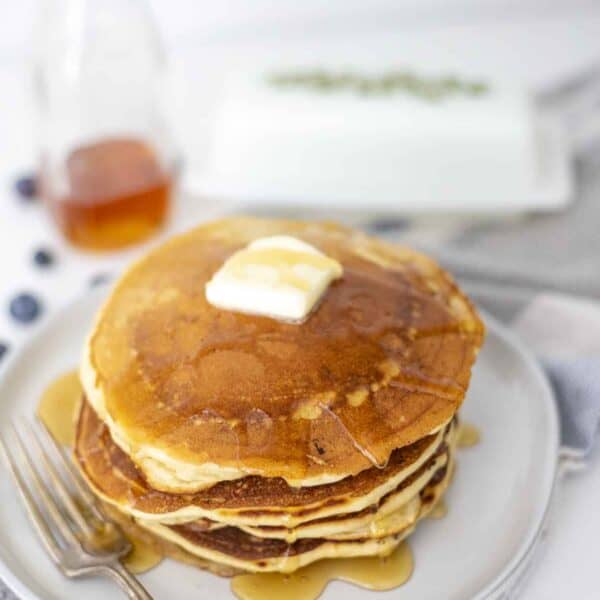






My starter is on day 2 and I’m loving it! Seeing great activity and I’m encouraged! I have a question for the future: After day 7, do I continue feeding it weekly with 1 cup water and 1 cup flour? Or do I need to up the amounts?
Weekly same amounts or more if you need more for your recipe!
Shouldn’t your starter double 3 days in a row before baking with it
Yes, that is ideal.
How liquidy is this supposed to be? I mixed 1 cup whole wheat floor with 1 cup water and it is very liquidy.
It is usually fairly runny. About like pancake batter.
Hi! Can a whole wheat sourdough starter be used in any of your recipes that call for an “active sourdough starter”?
I wish I found this before another. Only used 4 grams of flour. Less than 24 hours it’s doubled in size and full of bubbles. Can I start using 1 cup flour and water on day 2-3 or wait until it’s more established?
Thank you
Sue 😊
That’s great! You can start doing that.
Hi! I don’t see my last comment! I’ve done your instructions for 7 days… but now what recipe do you recommend trying? My cousin told me that I can’t really bake with a starter for 1 month? Any direction from here I’d love to know!
After seven days, as long as it is bubbly and active, you can bake with it!
Hi I’m on day 7. It rises and has gotten bubbly on top. What do you recommend making with it first? I kept the last 2 discards incase I could use them in something? Maybe I wasted a lot of flour bc I was feeding 1 c flour with 1 c water. Some other sites say you can’t bale with it for 2 weeks? Would that be feeding another week or sitting in the fridge a week, then feeding to bake. Thank you in advance!
I like to make a sandwich loaf! Here’s a recipe.
Hi! I was wondering why yeast isn’t an ingredient? I just started on day one of my whole wheat starter and thought it was odd yeast wasn’t an ingredient but I was gonna trust the process! Thank you so much
Youre making your own yeast when youre creating your starter!
Hello, I have been trying to make a sourdough starter for some time and I am never sure when it is bad or not. This last try is runny and had a very dark liquid on the top plus I missed a day of feeding it. Should I discard it and start again or will it be alright? Thank you for your time.
Remember, be kind, be calm and be safe, : -)
Respectfully
Shelagh Drew (drewgida(1))
Smile, maybe someone will smile back, : -)
I would discard most of the starter and then feed it again for several more days!
What temp should the water be for the starer?
Lukewarm